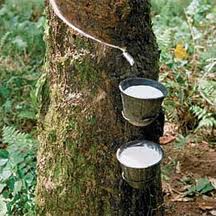Tapping trees – a genuine way to collect natural rubber all around the world
Sunday, October 30th, 2011 6:04:18 by M. Omer Iqbal bhatti
Tapping trees – a genuine way to collect natural rubber all around the world
The Mesoamerican peoples, such as the Mayans and the Aztecs, first tapped rubber from one of several trees found in Central and South America:
Hevea braziliensis: the most common commercial rubber tree from Brazil.
Hevea guyanensis: originally found in French Guyana.
Castilla elastica: sometimes called the Mexican rubber tree or the Panama rubber tree.
Explorers and colonists brought samples of these trees when they headed back to Europe. Eventually, seeds from these trees were transported to rubber plantations in other tropical climates during the era of European colonialism.
It takes about six years for a rubber tree to grow to a point where it’s economical to harvest the sap, which is called latex Here’s how you tap one: The collector makes a thin, diagonal cut to remove a sliver of bark. The milky-white latex fluid runs out
of the bark, much as blood would run out of a small superficial wound on your skin. The fluid runs down the cut and is collected in a bucket. After about six hours, the fluid stops flowing. In that six-hour period, a tree can usually fill a gallon bucket.
The tree can be tapped again with another fresh cut, usually the next day.
The Mesoamericans would dry the collected rubber latex and make balls and other things, like shoes. They would dip their feet in the latex and allow it to dry. After several dips and dryings, they could peel a shoe from their feet. Next, they smoked their
new rubber shoes to harden them. The Mesoamericans also waterproofed fabrics by coating them with latex and allowing it to dry. This process was used to make rubber items until around the 1800s.
While it was useful for waterproofing fabrics and making homemade shoes, rubber had its problems. You can see these problems for yourself with a simple rubber pencil eraser. Take that eraser and place it under intense heat for several minutes. What do you
see? The eraser should get very soft and sticky. Next, do the opposite — place the eraser on ice or in a freezer for several minutes. What do you see? The eraser should get hard and brittle. The same thing happened to early rubber. Imagine what it would be
like to walk around in your rubber shoes on a hot or cold day back then. The shoes wouldn’t wear well. Likewise, your rubberized clothing might stick to your chair while you were sitting, especially on a warm day.
Short URL: https://www.newspakistan.pk/?p=2069

















